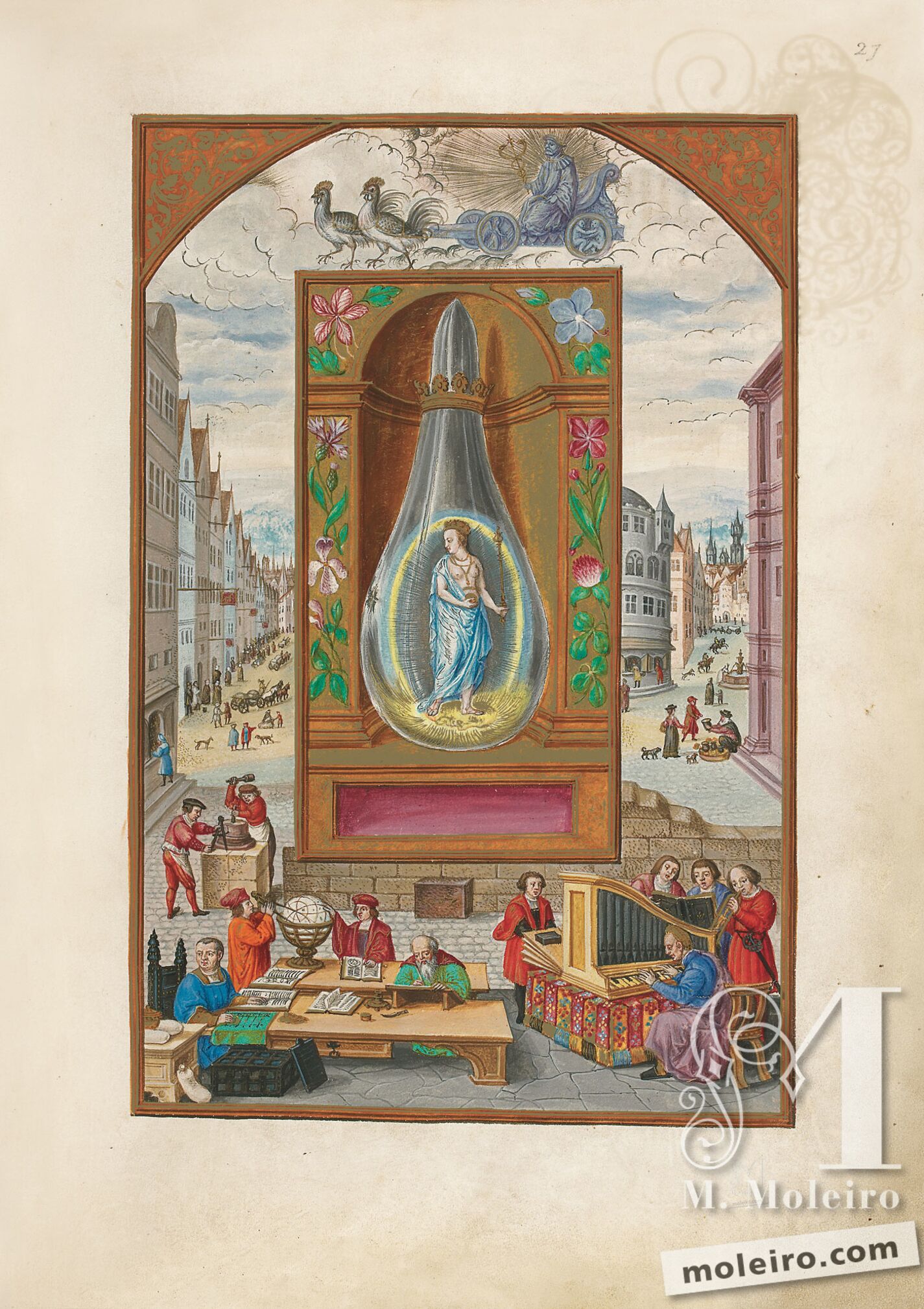This miniature, dated 1582, appears as the fifth in the series of planets, though Mercury should in fact be sixth in line. Presumably due to an error in the original source, a transposition of the miniatures of Mercury and Venus occurred in Harley MS. 3469, such that Venus in this case follows Mercury.
The planetary god Mercury orbits in his open chariot, drawn by two roosters rendered in grey. In his right hand he holds his attribute, a short golden staff entwined by serpents which is known as a caduceus. The earth beneath Mercury is portrayed as something of an urban streetscape where the people are engaged in artistic and academic pursuits or trades. The inset miniature shows a glass flask set in a semi-circular niche. Inside the flask is a queen with a crown on her head, a golden sceptre in her left hand and a golden apple in her right hand. The queen is clad in a light-coloured toga, her breasts exposed, and sandals. She is standing upon a golden head at the bottom of the flask. The head belongs to Mercury, whose face, surrounded by a resplendent glow and golden rays, gazes downwards. The figure of the queen is similarly encircled by a gleaming, striped gloriole and silver rays.
The motif of the white queen in the vas hermeticum can be traced back to a miniature in the Donum Dei. In analogy to the Christian doctrine of salvation, the queen is interpreted as the mother of the young prince who, in the originally following seventh and final illustration of the planet series, goes on to become the red king, symbolising the perfection of the alchemical work. As the inscription in the colour cartouche of the Nuremberg manuscript reads: “Filius natus ex me, major est me” (The son borne of me is greater than I). In her white robes, the queen simultaneously stands for the phase of albedo, the “small work” , this being the penultimate stage of transmutation which enables the creation of silver. There is little, if any, trace in the picture of the queen’s pregnancy which has at times been propagated in related reference literature.
Jörg Völlnagel
(Art historian, research associate at the Staatliche Museen zu Berlin)

This miniature, dated 1582, appears as the fifth in the series of planets, though Mercury should in fact be sixth in line. Presumably due to an error in the original source, a transposition of the miniatures of Mercury and Venus occurred in Harley MS. 3469, such that Venus in this case follows Mercury.
The planetary god Mercury orbits in his open chariot, drawn by two roosters rendered in grey. In his right hand he holds his attribute, a short golden staff entwined by serpents which is known as a caduceus. The earth beneath Mercury is portrayed as something of an urban streetscape where the people are engaged in artistic and academic pursuits or trades. The inset miniature shows a glass flask set in a semi-circular niche. Inside the flask is a queen with a crown on her head, a golden sceptre in her left hand and a golden apple in her right hand. The queen is clad in a light-coloured toga, her breasts exposed, and sandals. She is standing upon a golden head at the bottom of the flask. The head belongs to Mercury, whose face, surrounded by a resplendent glow and golden rays, gazes downwards. The figure of the queen is similarly encircled by a gleaming, striped gloriole and silver rays.
The motif of the white queen in the vas hermeticum can be traced back to a miniature in the Donum Dei. In analogy to the Christian doctrine of salvation, the queen is interpreted as the mother of the young prince who, in the originally following seventh and final illustration of the planet series, goes on to become the red king, symbolising the perfection of the alchemical work. As the inscription in the colour cartouche of the Nuremberg manuscript reads: “Filius natus ex me, major est me” (The son borne of me is greater than I). In her white robes, the queen simultaneously stands for the phase of albedo, the “small work” , this being the penultimate stage of transmutation which enables the creation of silver. There is little, if any, trace in the picture of the queen’s pregnancy which has at times been propagated in related reference literature.
Jörg Völlnagel
(Art historian, research associate at the Staatliche Museen zu Berlin)